Preparation and Characterization of Poly(ethylene-co-vinyl alcohol)/poly(ε-caprolactone) Blend for Bioscaffolding Applications
Abstract
1. Introduction
2. Results and Discussion
2.1. Miscibility
2.1.1. Preliminary Test
2.1.2. FTIR Analysis
2.1.3. DSC Analysis
Glass Transition Temperature
Melting Temperature
2.2. Mechanical Properties
2.3. Surface Wettability
2.4. Assessment of Cell Adhesion and Growth
2.5. Pore Morphology
2.5.1. Pore Interconnection
2.5.2. Pore Diameters and Porosities
3. Materials and Methods
3.1. Materials
3.2. Blend Preparation
3.3. Interconnected Pore Formation
3.4. Characterization
3.4.1. Blend Miscibility
3.4.2. Mechanic Properties
3.4.3. Surface Wettability
3.4.4. Water Absorbability
3.4.5. Cell Adhesion and Growth Tests
3.4.6. Porosity Evaluation
4. Conclusions
Author Contributions
Funding
Conflicts of Interest
References
- Raul, D.; Barlow, J. Polymer blends (or alloys). J. Macromol. Sci. Rev. Macromol. Chem. 1980, 18, 109–168. [Google Scholar]
- Utracki, L. Economics of polymer blends. Polym. Eng. Sci. 1982, 22, 1166–1175. [Google Scholar] [CrossRef]
- Robeson, L. Polymer Blends: A Comprehensive Review; Hanser: Munich, Germany, 2007. [Google Scholar]
- Ray, S.S.; Salehiyan, R. Nanostructured Immiscible Polymer Blends: Migration and Interface; Elsevier: Amsterdam, The Netherlands, 2019. [Google Scholar]
- Jagur-Grodzinski, J. Polymers for tissue engineering, medical devices, and regenerative medicine. Concise general review of recent studies. Polym. Adv. Technol. 2006, 17, 395–418. [Google Scholar] [CrossRef]
- Augustine, R.; Kalarikkal, N.; Thomas, S. Advancement of wound care from grafts to bioengineered smart skin substitutes. Prog. Biomater. 2014, 3, 103–113. [Google Scholar] [CrossRef] [PubMed]
- Augustine, R.; Dominic, E.A.; Reju, I.; Kaimal, B.; Kalarikkal, N.; Thomas, S. Electrospun poly (ε-caprolactone)-based skin substitutes: I n vivo evaluation of wound healing and the mechanism of cell proliferation. J. Biomed. Mater. Res. Part B. Appl. Biomater. 2015, 103, 1445–1454. [Google Scholar] [CrossRef] [PubMed]
- Tsai, W.-B.; Chen, C.-H.; Chen, J.-F.; Chang, K.-Y. The effects of types of degradable polymers on porcine chondrocyte adhesion, proliferation and gene expression. J. Mater. Sci. Mater. Med. 2006, 17, 337–343. [Google Scholar] [CrossRef] [PubMed]
- Ishaug-Riley, S.L.; Okun, L.E.; Prado, G.; Applegate, M.A.; Ratcliffe, A. Human articular chondrocyte adhesion and proliferation on synthetic biodegradable polymer films. Biomaterials 1999, 20, 2245–2256. [Google Scholar] [CrossRef]
- Lee, J.W.; Kim, Y.H.; Park, K.D.; Jee, K.S.; Shin, J.W.; Hahn, S.B. Importance of integrin β1-mediated cell adhesion on biodegradable polymers under serum depletion in mesenchymal stem cells and chondrocytes. Biomaterials 2004, 25, 1901–1909. [Google Scholar] [CrossRef]
- Abedalwafa, M.; Wang, F.; Wang, L.; Li, C. Biodegradable poly-epsilon-caprolactone (PCL) for tissue engineering applications: A review. Rev. Adv. Mater. Sci. 2013, 34, 123–140. [Google Scholar]
- Zhang, H.; Hollister, S. Comparison of bone marrow stromal cell behaviors on poly (caprolactone) with or without surface modification: Studies on cell adhesion, survival and proliferation. J. Biomater. Sci. Polym. Ed. 2009, 20, 1975–1993. [Google Scholar] [CrossRef]
- Mei, N.; Chen, G.; Zhou, P.; Chen, X.; Shao, Z.-Z.; Pan, L.-F.; Wu, C.-G. Biocompatibility of poly (ε-caprolactone) scaffold modified by chitosan—The fibroblasts proliferation in vitro. J. Biomater. Appl. 2005, 19, 323–339. [Google Scholar] [CrossRef] [PubMed]
- Lemoine, D.; Francois, C.; Kedzierewicz, F.; Preat, V.; Hoffman, M.; Maincent, P. Stability study of nanoparticles of poly (ɛ-caprolactone), poly (d, l-lactide) and poly (d, l-lactide-co-glycolide). Biomaterials 1996, 17, 2191–2197. [Google Scholar] [CrossRef]
- Shih, T.; Yang, J.; Jia, H.; Chen, J. Synthesis and Properties of Biodegradable Segmented Poly-ε-Caprolactone. J. Med. Biol. Eng. 2013, 34, 238–242. [Google Scholar] [CrossRef]
- Khatri, Z.; Jatoi, A.W.; Ahmed, F.; Kim, I.-S. Cell adhesion behavior of poly (ε-caprolactone)/poly (L-lactic acid) nanofibers scaffold. Mater. Lett. 2016, 171, 178–181. [Google Scholar] [CrossRef]
- de Biotecnología, G. Poly (vinylalcohol-co-ethylene) biodegradation on semi solid fermentation by Phanerochaete chrysosporium. Acta Farm. Bonaer. 2004, 23, 123–128. [Google Scholar]
- Kueng, W.; Silber, E.; Eppenberger, U. Quantification of cells cultured on 96-well plates. Analyt. Biochem. 1989, 182, 16–19. [Google Scholar] [CrossRef]
- Matsumura, K.; Hyon, S.H.; Nakajima, N.; Peng, C.; Tsutsumi, S. Surface modification of poly (ethylene-co-vinyl alcohol)(EVA). Part I. Introduction of carboxyl groups and immobilization of collagen. J. Biomed. Mater. Res. 2000, 50, 512–517. [Google Scholar] [CrossRef]
- Matsumura, K.; Hyon, S.-H.; Nakajima, N.; Iwata, H.; Watazu, A.; Tsutsumi, S. Surface modification of poly (ethylene-co-vinyl alcohol): Hydroxyapatite immobilization and control of periodontal ligament cells differentiation. Biomaterials 2004, 25, 4817–4824. [Google Scholar] [CrossRef]
- Hassanzadeh, F.; Farzan, M.; Varshosaz, J.; Khodarahmi, G.A.; Maaleki, S.; Rostami, M. Poly (ethylene-co-vinyl alcohol)-based polymeric thermo-responsive nanocarriers for controlled delivery of epirubicin to hepatocellular carcinoma. Res. Pharm. Sci. 2017, 12, 107. [Google Scholar] [CrossRef]
- Ekaputra, A.K.; Prestwich, G.D.; Cool, S.M.; Hutmacher, D.W. Combining electrospun scaffolds with electrosprayed hydrogels leads to three-dimensional cellularization of hybrid constructs. Biomacromolecules 2008, 9, 2097–2103. [Google Scholar] [CrossRef]
- Nam, Y.S.; Park, T.G. Porous biodegradable polymeric scaffolds prepared by thermally induced phase separation. J. Biomed. Mater. Res. 1999, 47, 8–17. [Google Scholar] [CrossRef]
- Hutmacher, D.W. Scaffolds in tissue engineering bone and cartilage. Biomaterials 2000, 21, 2529–2543. [Google Scholar] [CrossRef]
- Lee, J.H.; Park, T.G.; Park, H.S.; Lee, D.S.; Lee, Y.K.; Yoon, S.C.; Nam, J.-D. Thermal and mechanical characteristics of poly (L-lactic acid) nanocomposite scaffold. Biomaterials 2003, 24, 2773–2778. [Google Scholar] [CrossRef]
- Carletti, E.; Motta, A.; Migliaresi, C. Scaffolds for tissue engineering and 3D cell culture. In 3D Cell Culture; Springer: Berlin/Heidelberg, Germany, 2011; pp. 17–39. [Google Scholar]
- Pattison, M.A.; Wurster, S.; Webster, T.J.; Haberstroh, K.M. Three-dimensional, nano-structured PLGA scaffolds for bladder tissue replacement applications. Biomaterials 2005, 26, 2491–2500. [Google Scholar] [CrossRef]
- Kim, H.J.; Kim, U.J.; Leisk, G.G.; Bayan, C.; Georgakoudi, I.; Kaplan, D.L. Bone regeneration on macroporous aqueous-derived silk 3-D scaffolds. Macromol. Biosci. 2007, 7, 643–655. [Google Scholar] [CrossRef]
- Sokolsky-Papkov, M.; Agashi, K.; Olaye, A.; Shakesheff, K.; Domb, A.J. Polymer carriers for drug delivery in tissue engineering. Adv. Drug. Deliv. Rev. 2007, 59, 187–206. [Google Scholar] [CrossRef]
- Shin, M.; Abukawa, H.; Troulis, M.J.; Vacanti, J.P. Development of a biodegradable scaffold with interconnected pores by heat fusion and its application to bone tissue engineering. J. Biomed. Mater. Res. A 2008, 84, 702–709. [Google Scholar] [CrossRef]
- Yoon, J.J.; Song, S.H.; Lee, D.S.; Park, T.G. Immobilization of cell adhesive RGD peptide onto the surface of highly porous biodegradable polymer scaffolds fabricated by a gas foaming/salt leaching method. Biomaterials 2004, 25, 5613–5620. [Google Scholar]
- Yamada, K.M.; Kennedy, D.W. Dualistic nature of adhesive protein function: Fibronectin and its biologically active peptide fragments can autoinhibit fibronectin function. J. Cell Biol. 1984, 99, 29–36. [Google Scholar] [CrossRef]
- Moskala, E.; Varnell, D.; Coleman, M. Concerning the miscibility of poly (vinyl phenol) blends—FTI. R. study. Polymer 1985, 26, 228–234. [Google Scholar] [CrossRef]
- Jutier, J.J.; Lemieux, E.; Prud’Homme, R.E. Miscibility of polyester/nitrocellulose blends: A DSC and FTIR study. J. Polym. Sci. B Polym. Phys. 1988, 26, 1313–1329. [Google Scholar] [CrossRef]
- El-Hadi, A.M. Improvement of the Miscibility by Combination of Poly (3-hydroxy butyrate) PHB and Poly (propylene carbonate) PPC with Additives. J. Polym. Environ. 2017, 25, 728–738. [Google Scholar] [CrossRef]
- Lee, J.Y.; Painter, P.C.; Coleman, M.M. Hydrogen bonding in polymer blends. 4. Blends involving polymers containing methacrylic acid and vinylpyridine groups. Macromolecules 1988, 21, 954–960. [Google Scholar] [CrossRef]
- Lichkus, A.M.; Painter, P.C.; Coleman, M.M. Hydrogen bonding in polymer blends. 5. Blends involving polymers containing methacrylic acid and oxazoline groups. Macromolecules 1988, 21, 2636–2641. [Google Scholar] [CrossRef]
- Roberts, J.D.; Caserio, M.C. Special Offers and Product Promotions; WA Benjamin: San Francisco, CA, USA, 1977. [Google Scholar]
- Qiu, Z.; Ikehara, T.; Nishi, T. Miscibility and crystallization in crystalline/crystalline blends of poly (butylene succinate)/poly (ethylene oxide). Polymer 2003, 44, 2799–2806. [Google Scholar] [CrossRef]
- Zeng, J.-B.; Zhu, Q.-Y.; Li, Y.-D.; Qiu, Z.-C.; Wang, Y.-Z. Unique crystalline/crystalline polymer blends of poly (ethylene succinate) and poly (p-dioxanone): Miscibility and crystallization behaviors. J. Phys. Chem. B 2010, 114, 14827–14833. [Google Scholar] [CrossRef]
- Tiptipakorn, S.; Keungputpong, N.; Phothiphiphit, S.; Rimdusit, S. Effects of polycaprolactone molecular weights on thermal and mechanical properties of polybenzoxazine. J. Appl. Polym. Sci. 2015, 132, 1–11. [Google Scholar] [CrossRef]
- Utracki, L.A.; Wilkie, C.A. Polymer Blends Handbook; Springer: Berlin/Heidelberg, Germany, 2002; Volume 1. [Google Scholar]
- Fox, T.G. Influence of Diluent and of Copolymer Composition on the Glass Temperature of a Poly-mer System. Bull. Am. Phys. Soc. 1956, 1, 123. [Google Scholar]
- Gordon, M.; Taylor, J.S. Ideal copolymers and the second-order transitions of synthetic rubbers. I. Non-crystalline copolymers. J. Appl. Chem. 1952, 2, 493–500. [Google Scholar] [CrossRef]
- de Lima, J.A.; Felisberti, M.I. Poly (ethylene-co-vinyl alcohol) and poly (methyl methacrylate) blends: Phase behavior and morphology. Eur. Polym. J. 2008, 44, 1140–1148. [Google Scholar] [CrossRef]
- Nishi, T.; Wang, T. Melting point depression and kinetic effects of cooling on crystallization in poly (vinylidene fluoride)-poly (methyl methacrylate) mixtures. Macromolecules 1975, 8, 909–915. [Google Scholar] [CrossRef]
- Guarino, V.; Causa, F.; Netti, P.A.; Ciapetti, G.; Pagani, S.; Martini, D.; Baldini, N.; Ambrosio, L. The role of hydroxyapatite as solid signal on performance of PCL porous scaffolds for bone tissue regeneration. J. Biomed. Mater. Res. B 2008, 86, 548–557. [Google Scholar] [CrossRef] [PubMed]
- Choi, W.-Y.; Kim, H.-E.; Koh, Y.-H. Production, mechanical properties and in vitro biocompatibility of highly aligned porous poly (ε-caprolactone)(PCL)/hydroxyapatite (HA) scaffolds. J. Porous Mater. 2013, 20, 701–708. [Google Scholar] [CrossRef]
- Salerno, A.; Zeppetelli, S.; Oliviero, M.; Battista, E.; Di Maio, E.; Iannace, S.; Netti, P.A. Microstructure, degradation and in vitro MG63 cells interactions of a new poly (ε-caprolactone), zein, and hydroxyapatite composite for bone tissue engineering. J. Bioact. Compat. Polym. 2012, 27, 210–226. [Google Scholar] [CrossRef]
- Domingos, M.; Intranuovo, F.; Gloria, A.; Gristina, R.; Ambrosio, L.; Bártolo, P.; Favia, P. Improved osteoblast cell affinity on plasma-modified 3-D extruded PCL scaffolds. Acta Biomater. 2013, 9, 5997–6005. [Google Scholar] [CrossRef]
- Milovac, D.; Ferrer, G.G.; Ivankovic, M.; Ivankovic, H. PCL-coated hydroxyapatite scaffold derived from cuttlefish bone: Morphology, mechanical properties and bioactivity. Matr. Sci. Eng. C 2014, 34, 437–445. [Google Scholar] [CrossRef]
- Nicoll, S.B. Materials for bone graft substitutes and osseous tissue regeneration. In Biomaterial for Tissue Engineering Applications; Springer: Berlin/Heidelberg, Germany, 2011; pp. 343–362. [Google Scholar]
- Susano, M.A.; Leonor, I.B.; Reis, R.L.; Azevedo, H.S. Elastic biodegradable starch/ethylene-co-vinyl alcohol fibre-mesh scaffolds for tissue engineering applications. J. Appl. Polym. Sci. 2014, 131, 1–10. [Google Scholar] [CrossRef]
- Nasri-Nasrabadi, B.; Behzad, T.; Bagheri, R. Preparation and characterization of cellulose nanofiber reinforced thermoplastic starch composites. Fibers Polym. 2014, 15, 347–354. [Google Scholar] [CrossRef]
- ASM International. Materials and Coatings for Medical Devices: Cardiovascular; ASM International: Materials Park, OH, USA, 2009. [Google Scholar]
- Thadavirul, N.; Pavasant, P.; Supaphol, P. Improvement of dual-leached polycaprolactone porous scaffolds by incorporating with hydroxyapatite for bone tissue regeneration. J. Biomater. Sci. Polym. Ed. 2014, 25, 1986–2008. [Google Scholar] [CrossRef]
- Wei, G.; Ma, P.X. Structure and properties of nano-hydroxyapatite/polymer composite scaffolds for bone tissue engineering. Biomaterials 2004, 25, 4749–4757. [Google Scholar] [CrossRef]
- Leszczak, V.; Baskett, D.A.; Popat, K.C. Smooth muscle cell functionality on collagen immobilized polycaprolactone nanowire surfaces. J. Funct. Biomater. 2014, 5, 58–77. [Google Scholar] [CrossRef] [PubMed]
- Bružauskaitė, I.; Bironaitė, D.; Bagdonas, E.; Bernotienė, E. Scaffolds and cells for tissue regeneration: Different scaffold pore sizes—Different cell effects. Cytotechnology 2016, 68, 355–369. [Google Scholar] [CrossRef] [PubMed]
- Han, D.K.; Ahn, K.-D.; Kim, J.-m.; Ju, Y.M. Biodegradable Porous Polymer Scaffolds for Tissue Engineering Prepared from an Effervescent Mixture and its Preparation. U.S. Patent 6,562,374B1, 13 May 2003. [Google Scholar]
- Yang, Q.; Chen, L.; Shen, X.; Tan, Z. Preparation of polycaprolactone tissue engineering scaffolds by improved solvent casting/particulate leaching method. J. Macromol. Sci. B Phys. 2006, 45, 1171–1181. [Google Scholar] [CrossRef]
- Han, K.-S.; Song, J.E.; Tripathy, N.; Kim, H.; Moon, B.M.; Park, C.H.; Khang, G. Effect of pore sizes of silk scaffolds for cartilage tissue engineering. Macromol. Res. 2015, 23, 1091–1097. [Google Scholar] [CrossRef]
- Saeed, W.S.; Al-Odayni, A.-B.; Ali Alghamdi, A.; Abdulaziz Al-Owais, A.; Semlali, A.; Aouak, T. Miscibility of Poly (Ethylene-co-Vinylalcohol)/Poly (δ-Valerolactone) Blend and Tissue Engineering Scaffold Fabrication Using Naphthalene as Porogen. Polym. Plast. Technol. Mater. 2019, 58, 1–23. [Google Scholar] [CrossRef]
- Semlali, A.; Chakir, J.; Goulet, J.P.; Chmielewski, W.; Rouabhia, M. Whole cigarette smoke promotes human gingival epithelial cell apoptosis and inhibits cell repair processes. J. Periodontal Res. 2011, 46, 533–541. [Google Scholar] [CrossRef]
- Semlali, A.; Chakir, J.; Rouabhia, M. Effects of whole cigarette smoke on human gingival fibroblast adhesion, growth, and migration. J. Toxic. Environ. Health A 2011, 74, 848–862. [Google Scholar] [CrossRef]

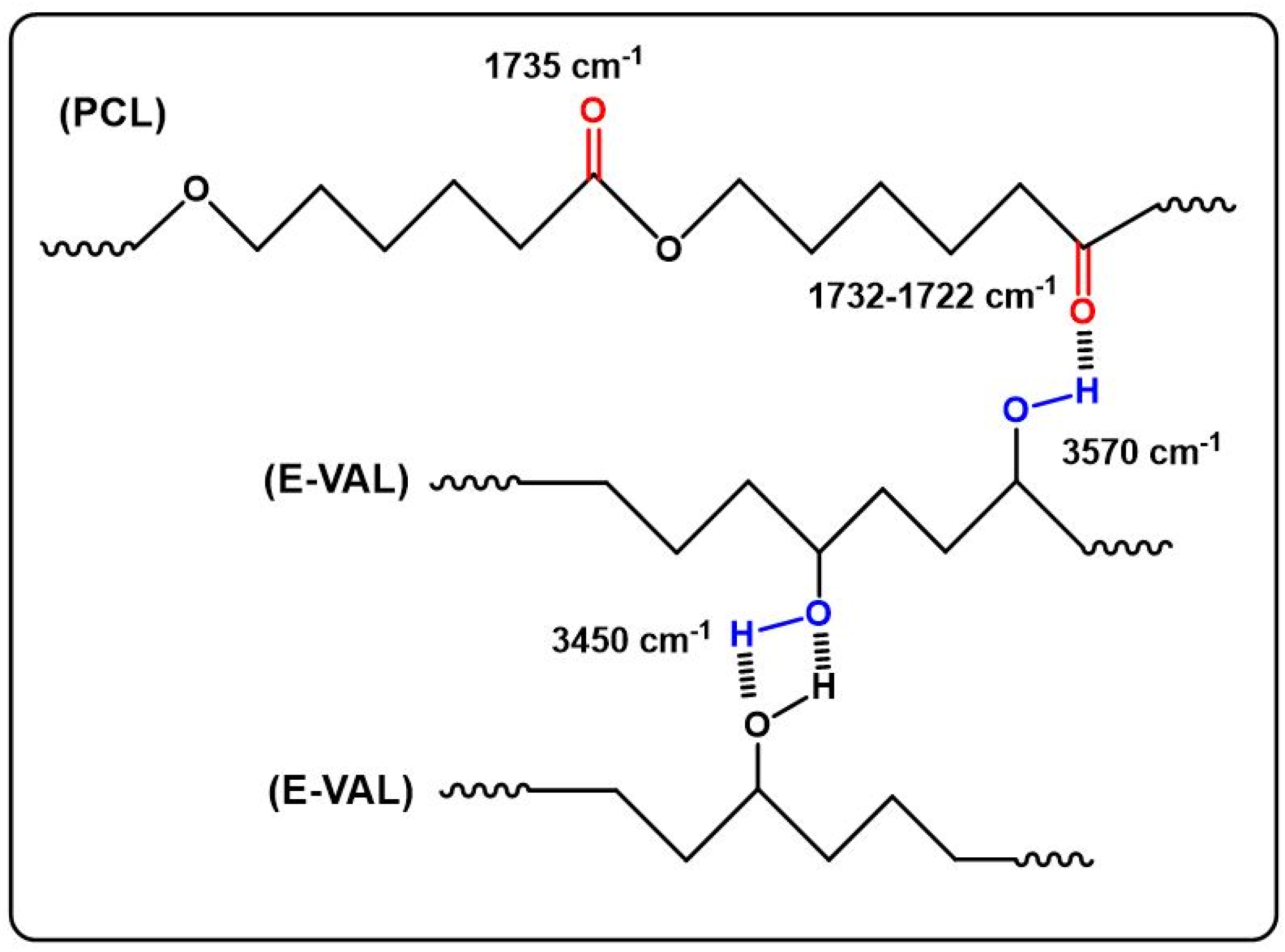
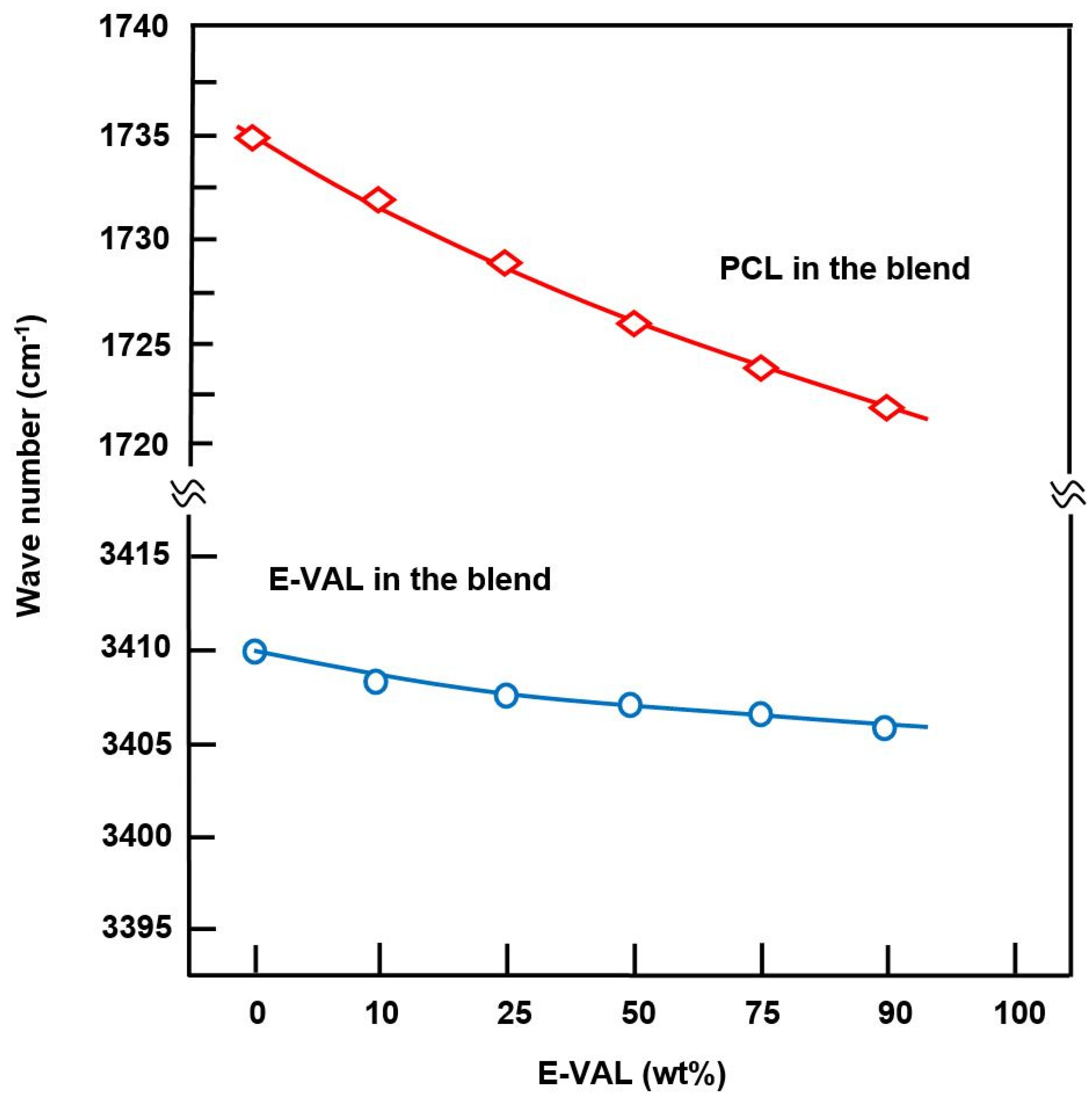

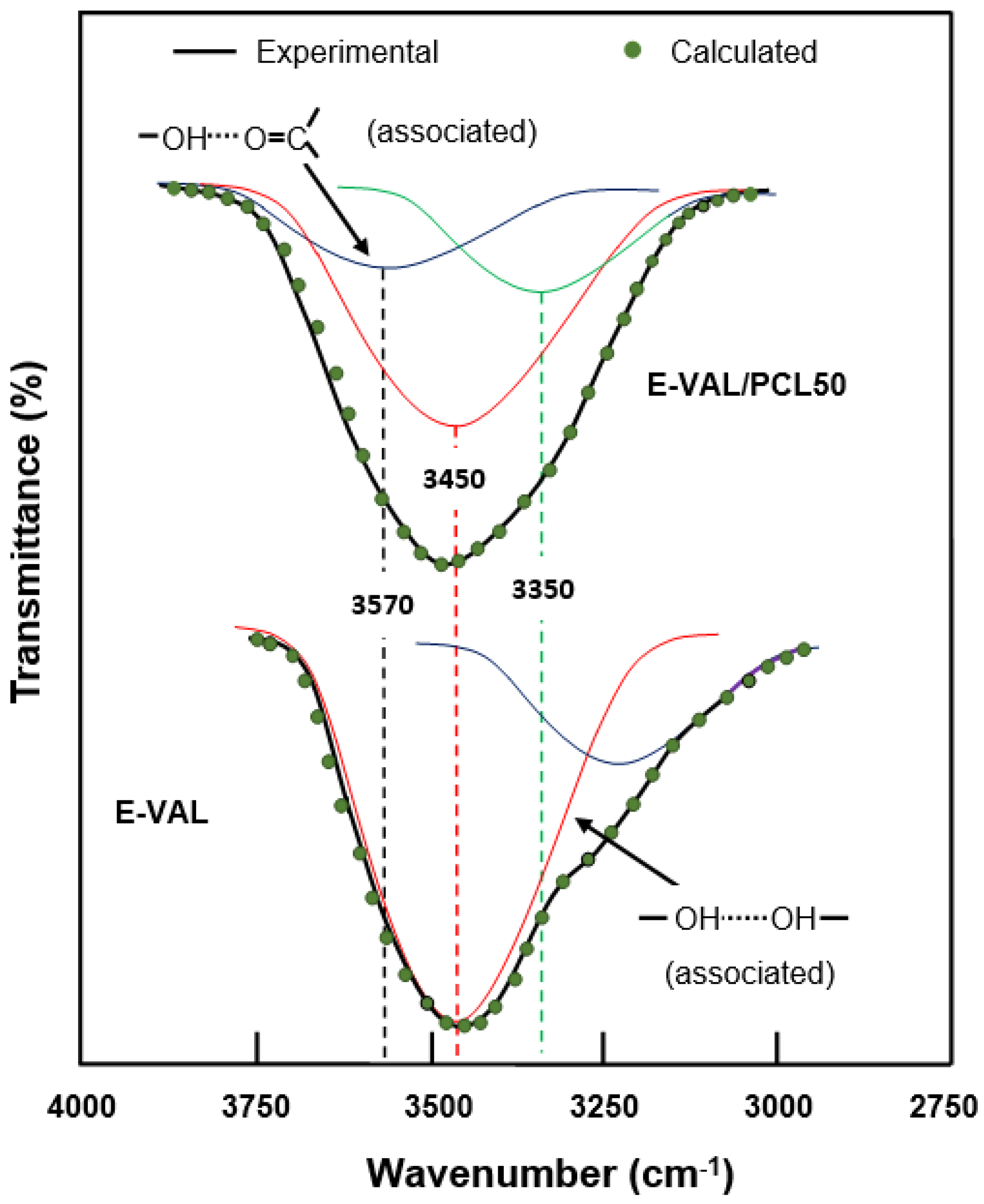
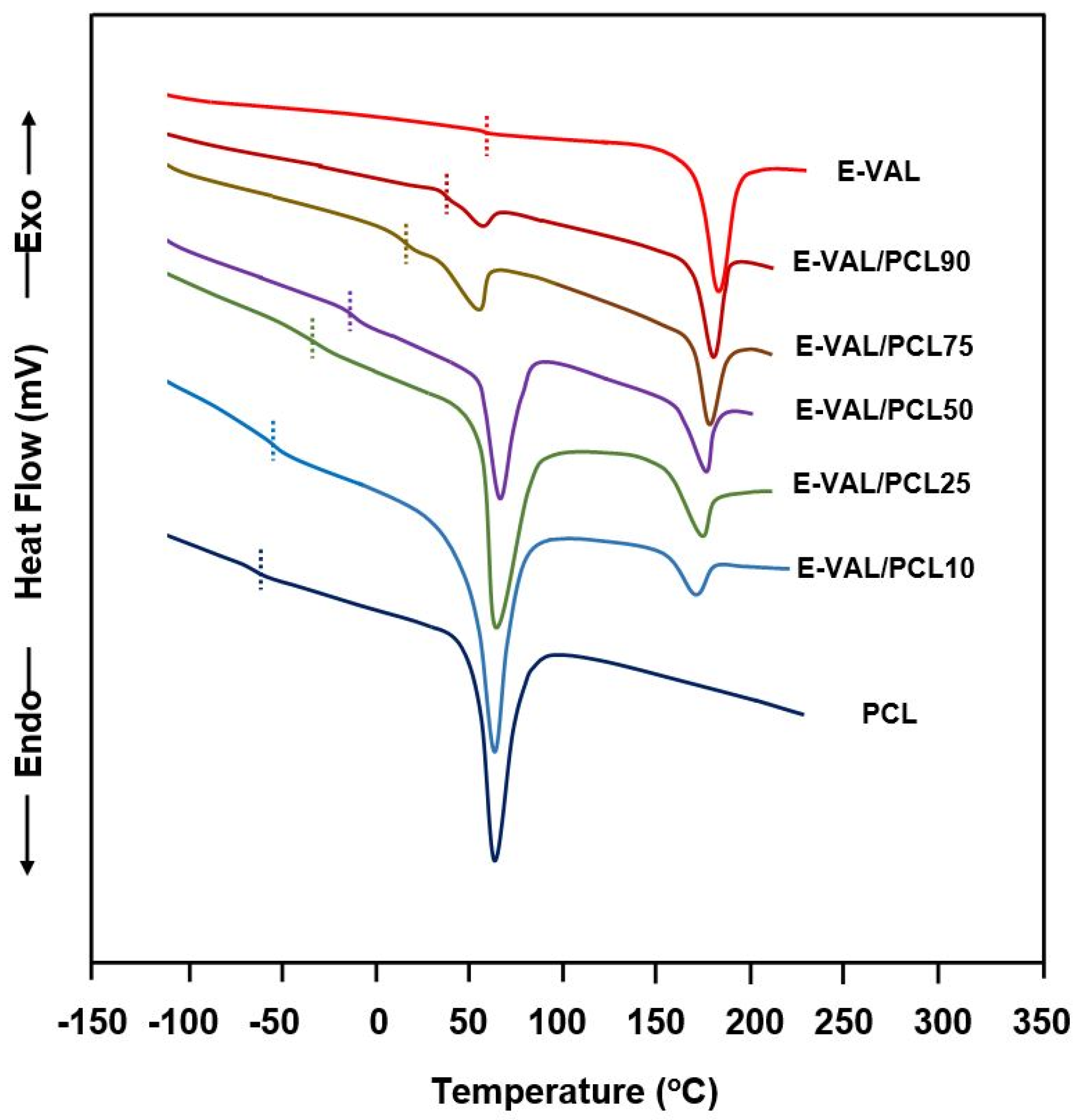

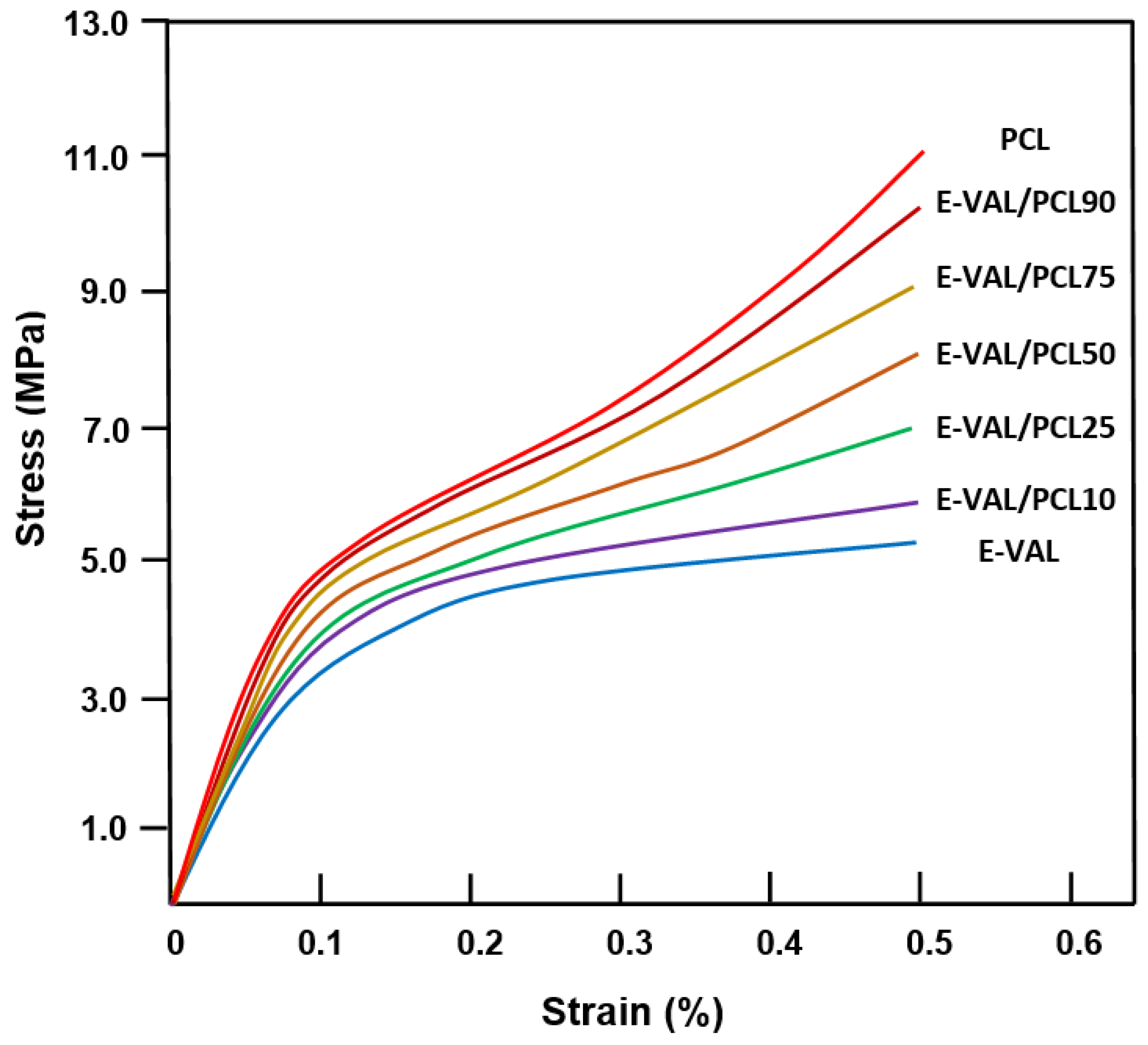
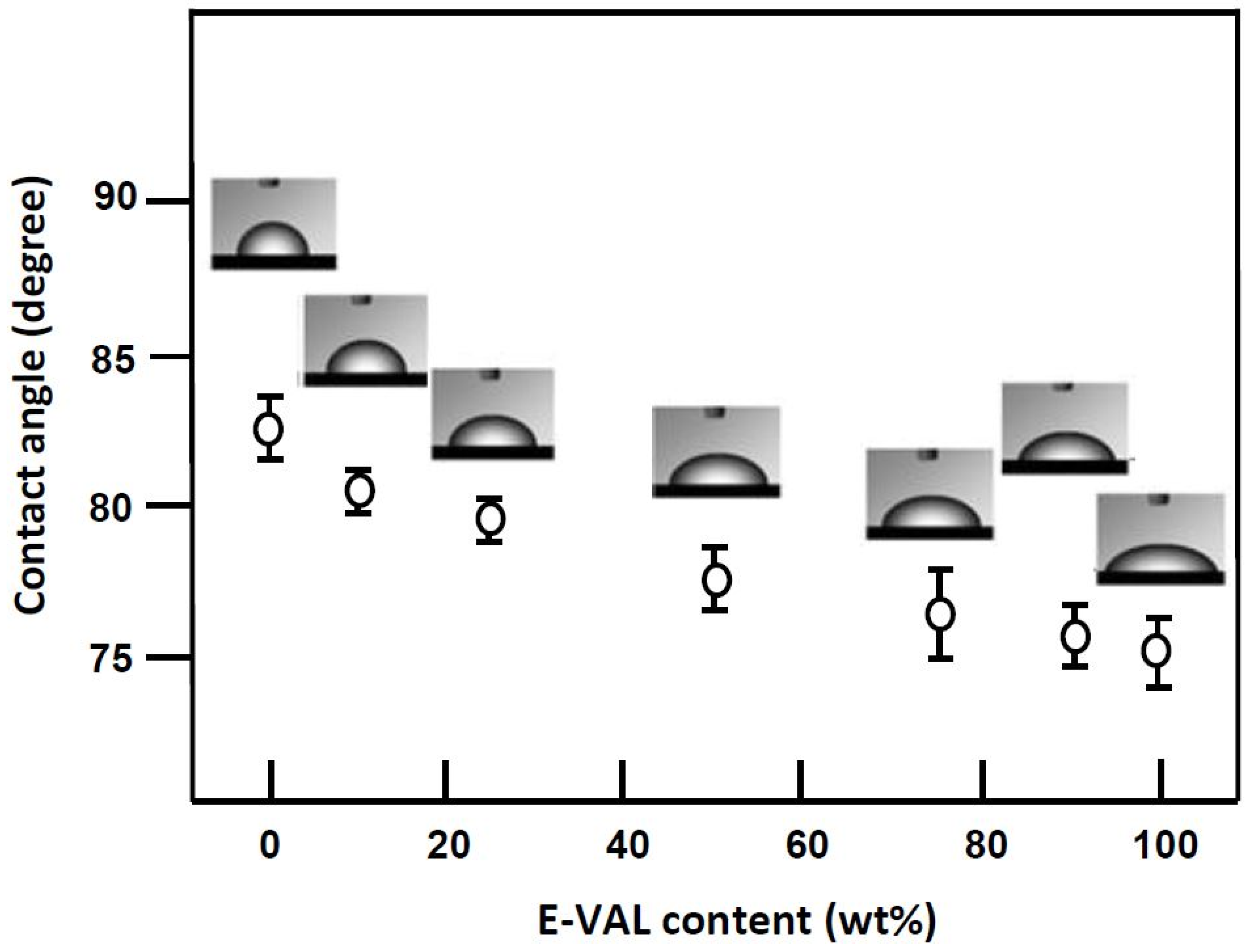
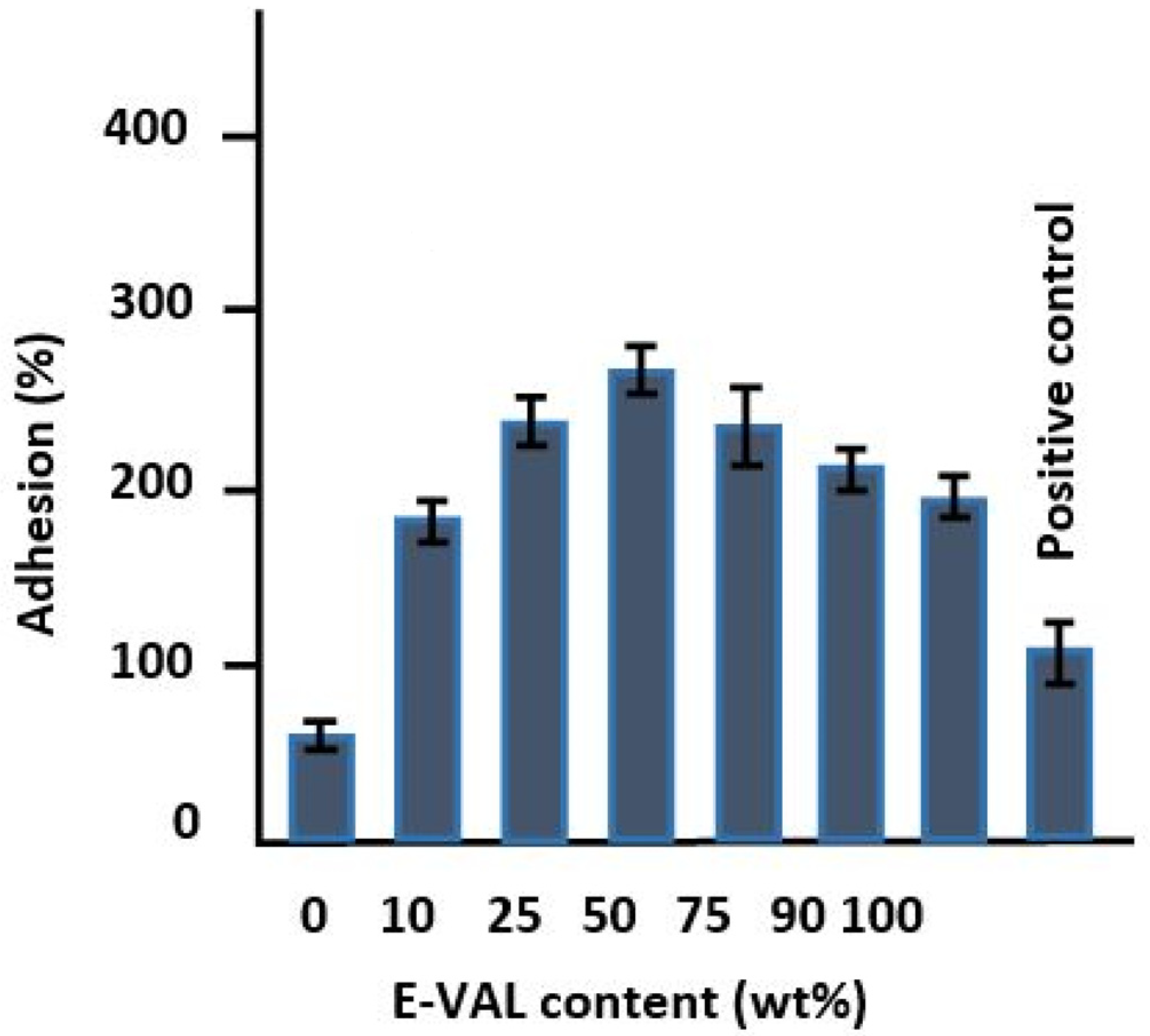
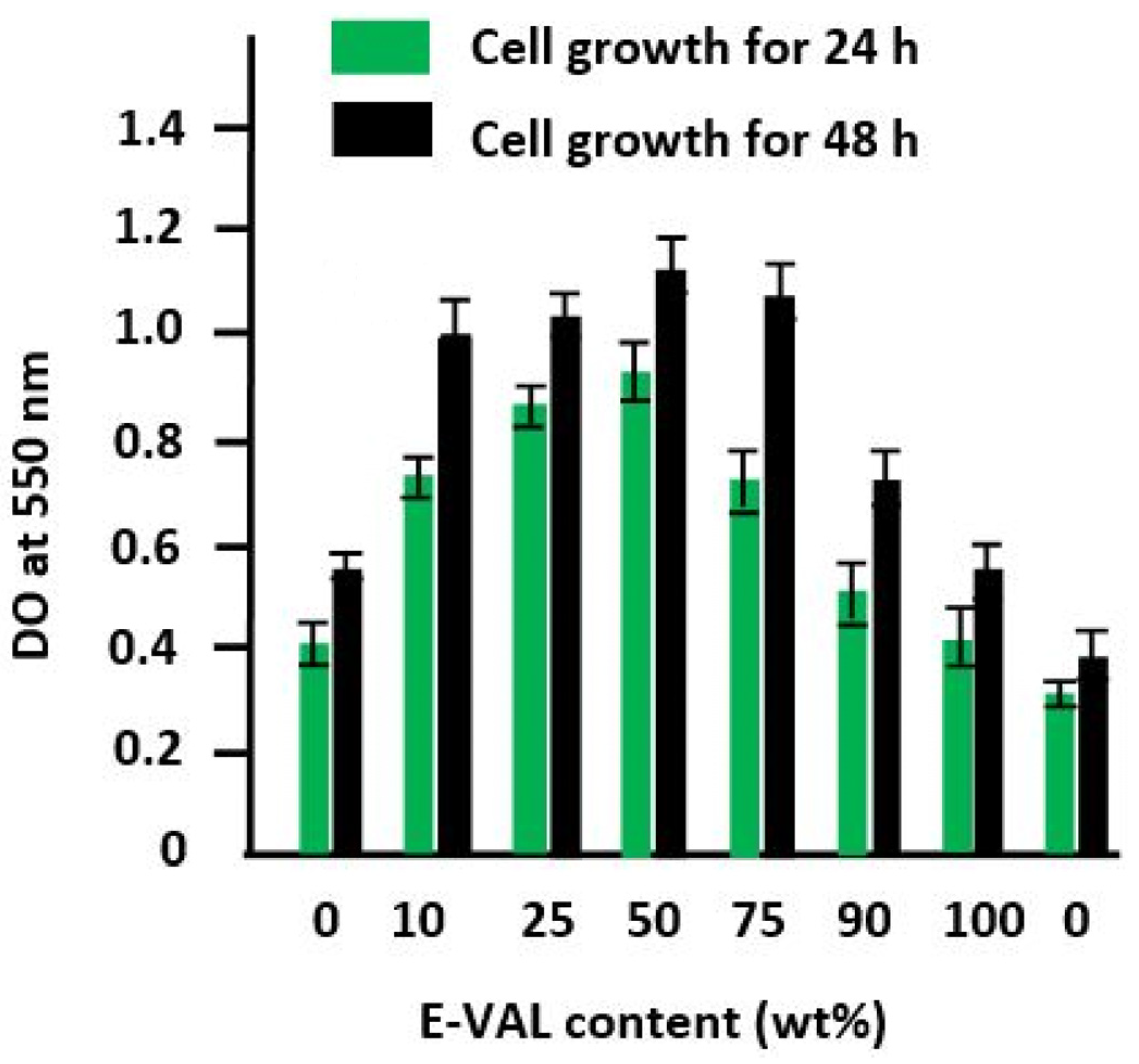
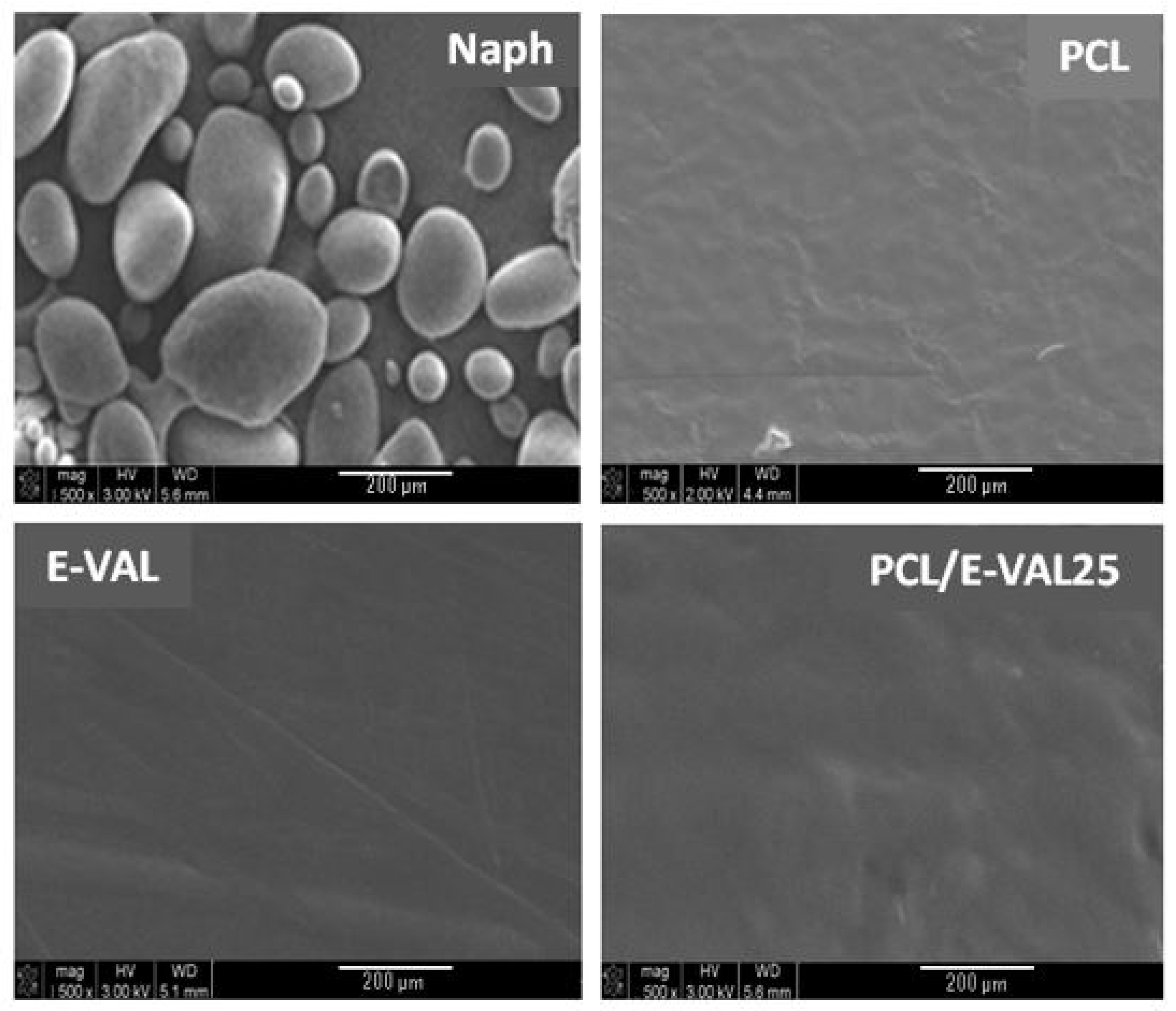
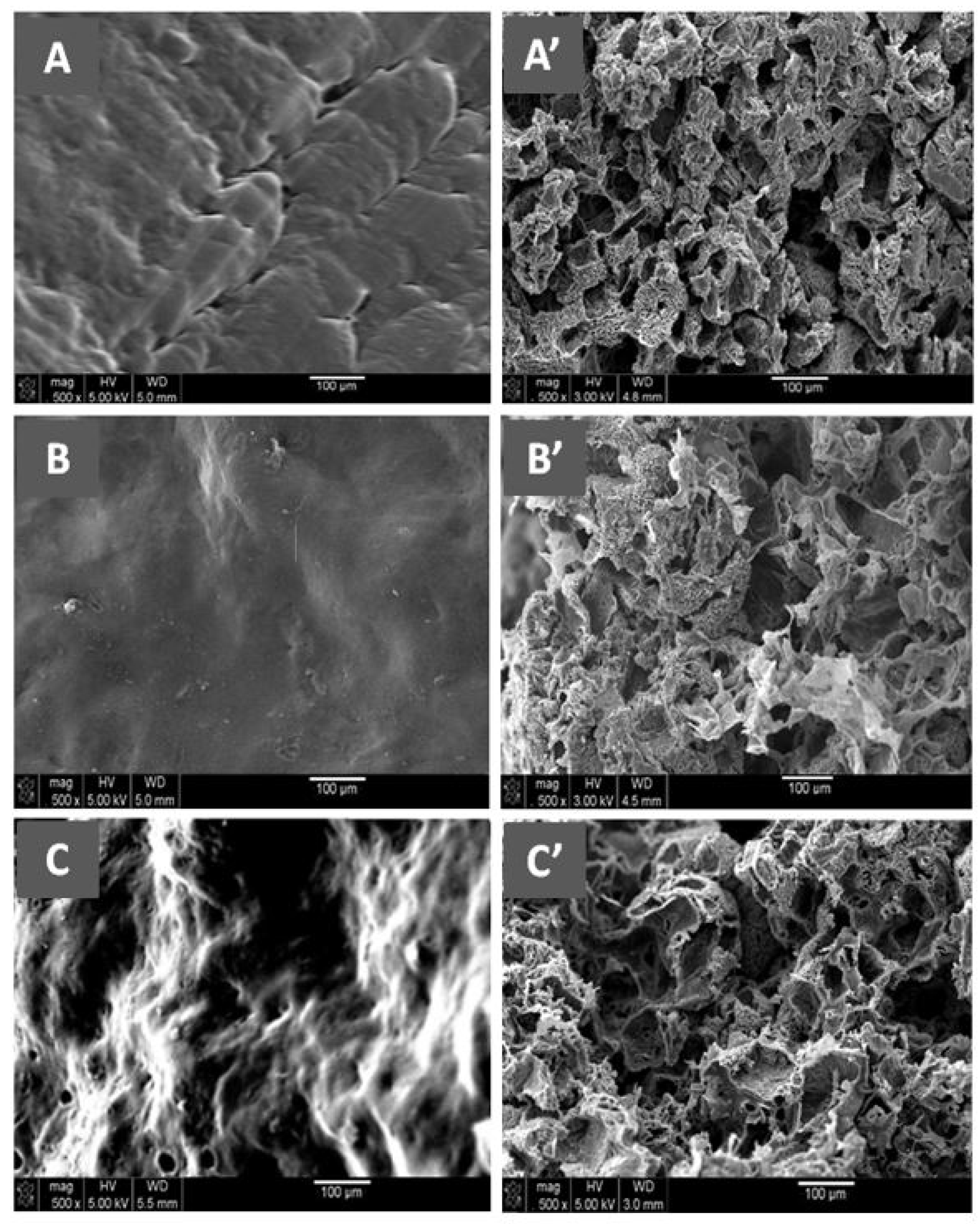
| Blend | Carbonyl Associated | Carbonyl Free | F1 | ||
|---|---|---|---|---|---|
| Aa (unit2) | ν (cm−1) | Ana (unit2) | ν (cm−1) | ||
| 10:90 | 13.8 | 1736 | 77.0 | 1770 | 0.16 |
| 25:75 | 24.4 | 1737 | 61.6 | 1754 | 0.30 |
| 50:50 | 37.6 | 1737 | 68.0 | 1756 | 0.38 |
| 75:25 | 16.8 | 1737 | 88.0 | 1754 | 0.17 |
| 90:10 | 44.0 | 1738 | 48.0 | 1755 | 0.50 |
| System E-VAL/PCL | (°C) | (°C) | (°C) | (°C) |
|---|---|---|---|---|
| (100:0) | 58 | - | - | - |
| (90:10) | 35 | 58.2 | 40.5 | 41.1 |
| (75:25) | 16 | 28.5 | 18.0 | 18.7 |
| (50:50) | −14 | −1.0 | −14.0 | −12.8 |
| (25:75) | −43 | −30.5 | −39.0 | −38.5 |
| (10:90) | −53 | −48.2 | −52.1 | −52.0 |
| (0:100) | −60 | - | - | - |
| System E-VAL/PCL | PCL | E-VAL | ||
|---|---|---|---|---|
| Tm (°C) | ΔHm (J·g−1) | Tm (°C) | ΔHm (J·g−1) | |
| (100:0) | - | - | 183 | 73.70 |
| (90:10) | 52 | 8.34 | 180 | 47.83 |
| (75:25) | 56 | 14.18 | 178 | 31.32 |
| (50:50) | 67 | 45.46 | 177 | 27.02 |
| (25:75) | 65 | 69.19 | 175 | 24.57 |
| (10:90) | 64 | 73.12 | 167 | 19.65 |
| (0:100) | 62 | 75.10 | - | - |
| Scaffold | E (MPa) | σ (MPa) |
|---|---|---|
| PCL | 66.67 ± 1.23 | 11.06 ± 1.11 |
| E-VAL/PCL90 | 60.05 ± 1.37 | 10.25 ± 1.08 |
| E-VAL/PCL75 | 54.32 ± 1.33 | 9.06 ± 1.04 |
| E-VAL/PCL50 | 50.43 ± 1.20 | 8.03 ± 0.85 |
| E-VAL/PCL25 | 46.15 ± 1.43 | 7.00 ± 0.64 |
| E-VAL/PCL10 | 42.86 ± 1.20 | 5.90 ± 0.61 |
| E-VAL | 37.50 ± 1.56 | 5.25 ± 0.44 |
| System | Average Porogen Diameter (μm) | Pore Diameter (μm) | Porosity (%) |
|---|---|---|---|
| PCL | 120–190 | 40–150 | 82.35 |
| E-VAL/PCL10 | 120–190 | 57–165 | 85.12 |
| E-VAL/PCL25 | 120–190 | 60–130 | 86.83 |
| E-VAL/PCL50 | 120–190 | 73–140 | 88.03 |
| E-VAL/PCL75 | 120–190 | 56–130 | 82.22 |
| E-VAL/PCL90 | 120–190 | 53–114 | 80.32 |
| E-VAL | 120–190 | 50–80 | 75.12 |
| Sample | E-VAL/PCL (wt%) | E-VAL (g) | PCL (g) |
|---|---|---|---|
| PCL | 100:0 | 0 | 10.0 |
| E-VAL/PCL90 | 90:10 | 1.0 | 9.0 |
| E-VAL/PCL75 | 75:25 | 2.5 | 7.5 |
| E-VAL/PCL50 | 50:50 | 5.0 | 5.0 |
| E-VAL/PCL25 | 25:75 | 7.5 | 2.5 |
| E-VAL/PCL10 | 10:90 | 9.0 | 1.0 |
| E-VAL | 0:100 | 10 | 0 |
© 2020 by the authors. Licensee MDPI, Basel, Switzerland. This article is an open access article distributed under the terms and conditions of the Creative Commons Attribution (CC BY) license (http://creativecommons.org/licenses/by/4.0/).
Share and Cite
Alghamdi, A.A.; Alattas, H.; Saeed, W.S.; Al-Odayni, A.-B.; Alrahlah, A.; Aouak, T. Preparation and Characterization of Poly(ethylene-co-vinyl alcohol)/poly(ε-caprolactone) Blend for Bioscaffolding Applications. Int. J. Mol. Sci. 2020, 21, 5881. https://doi.org/10.3390/ijms21165881
Alghamdi AA, Alattas H, Saeed WS, Al-Odayni A-B, Alrahlah A, Aouak T. Preparation and Characterization of Poly(ethylene-co-vinyl alcohol)/poly(ε-caprolactone) Blend for Bioscaffolding Applications. International Journal of Molecular Sciences. 2020; 21(16):5881. https://doi.org/10.3390/ijms21165881
Chicago/Turabian StyleAlghamdi, Abdulaziz Ali, Hussain Alattas, Waseem Sharaf Saeed, Abdel-Basit Al-Odayni, Ali Alrahlah, and Taieb Aouak. 2020. "Preparation and Characterization of Poly(ethylene-co-vinyl alcohol)/poly(ε-caprolactone) Blend for Bioscaffolding Applications" International Journal of Molecular Sciences 21, no. 16: 5881. https://doi.org/10.3390/ijms21165881
APA StyleAlghamdi, A. A., Alattas, H., Saeed, W. S., Al-Odayni, A.-B., Alrahlah, A., & Aouak, T. (2020). Preparation and Characterization of Poly(ethylene-co-vinyl alcohol)/poly(ε-caprolactone) Blend for Bioscaffolding Applications. International Journal of Molecular Sciences, 21(16), 5881. https://doi.org/10.3390/ijms21165881







